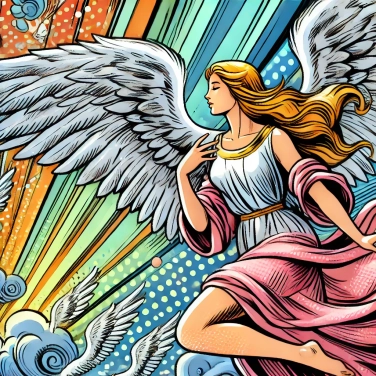Wings in angel images from Western cultures are often inspired by angels from the Judeo-Christian tradition, as described in the Bible. The wings are associated with the ability of these celestial beings to move quickly between heaven and earth, symbolizing their spiritual and divine nature.

In the Bible, angels often appear as messengers between God and humans, but contrary to popular belief, they are not always clearly described with wings. However, some passages explicitly mention winged celestial beings: in particular, the cherubim and seraphim, described in the Old Testament, notably in the books of Ezekiel and Isaiah, which clearly speak of beings with multiple wings. These biblical descriptions became popular in Christian religious circles from the early centuries, prompting artists to visually represent all angels with wings, a practical means to clearly express their divine origin and their ability to move between the celestial and earthly realms. Wings thus became an immediate visual shortcut to symbolize their role as swift and supernatural messengers sent by God to humans.
The wings of angels primarily symbolize the connection between the earthly and the divine, between humanity and God. They also mark their ability to move swiftly from one world to another, thus showing that angels are fundamentally messengers. Having wings embodies the idea of purity, spiritual elevation, the visual proof that they are above material concerns. More simply, the wings remind us that angels are truly different from us: not limited by space or time, nor stuck on Earth like humans. Finally, they serve to visually express their role as protectors, able to surround and shelter believers under their benevolent wings.
Winged angelic images in Western art do not come from nowhere: they owe much to ancient representations. Greeks and Romans already loved to fill their works with winged characters: Eros, the god of love with his charming little wings, or Nike (Victory), with her impressive large wings symbolizing speed and divine power. Then, with the Christian Middle Ages, it’s simple, artists did what they did best: mix it all together. They drew directly from these ancient visual traditions by adopting styles, postures, and even proportions they knew well, in order to represent their angels in a way that was more striking or familiar to their audience. Even in Byzantine art, where the decor is rather fixed and strict, angels often retain wings to remind us of their divine and supernatural origins.
Many ancient cultures have winged mythological figures, but their meanings vary. For example, Christian angels primarily symbolize the connection to heaven, purity, and the ability to travel between worlds.
On the Greek side, there’s Hermes with his winged sandals: he represents speed and serves as a messenger between gods and humans, a somewhat similar idea. Among the Egyptians, there’s Isis, sometimes depicted with large outstretched wings, symbolizing protection, motherhood, and divine power.
On the other hand, there are also very different winged creatures. For instance, Greek mythology has the Harpies, feathered monsters that aren’t exactly nice, representing punishment or vengeance. In contrast, angels appear to be quite benevolent.
So ultimately, having wings doesn’t always mean the same thing: it can indicate a positive connection to the divine, but also a threat or simply speed and freedom.
Modern representations of winged angels in Western culture have strayed significantly from classical canons. Now present everywhere, from cinema to video games to advertising, angels appear in very varied forms. In fantasy, they are often depicted as powerful warriors with spectacular wings, emphasizing their heroic or threatening side. For others, angels become hyper-human characters or even flawed, far from the traditional model of the divine messenger. TV series like Supernatural, films like Constantine, and comics and mangas take these winged symbols and greatly alter their original religious meaning. Today, wings are sometimes simply aesthetic or serve to express a form of spiritual or personal freedom, far from any divine mission.
Despite their omnipresence in Western art, the sacred writings themselves are remarkably brief regarding the actual physical appearance of angels. Thus, wings are primarily an artistic and cultural invention meant to symbolically convey the idea of a celestial and transcendent being.
Many representations of winged angels from the Middle Ages were directly inspired by the winged figures of ancient Greco-Roman and Egyptian art, such as winged victories or protective genies, thus reusing ancient symbols to represent a renewed Christian spirituality.
Since the 19th century, certain Western esoteric traditions have reclaimed the classical representations of winged angels, integrating them into modern spiritual practices such as tarot or various guided meditation systems related to angels.
In the angelic hierarchy proposed by the medieval theologian Pseudo-Dionysius the Areopagite, only certain types of angels (such as the Seraphim and Cherubim) are traditionally described explicitly with multiple wings, demonstrating their closeness to the divine and their symbolic power.
No, many other cultures include supernatural or celestial beings with wings. However, the specific way that angels with wings are depicted today in the West is primarily the result of biblical, cultural, and artistic influences unique to Western Christianity.
Yes, some Western artistic and cultural representations indeed depict angels without wings, but these are relatively rare. Generally, a specific attribute or context helps to identify them as angels in these particular cases.
Today, representations of angels often include contemporary or fantastical elements and can be influenced by popular culture (cinema, comics, video games). The traditional aesthetic and symbolic aspects from the Middle Ages have gradually blended with modern interpretations, thereby adapting their cultural significance.
Wings traditionally symbolize speed, divinity, and the ability to freely cross the boundaries between heaven and earth. They embody the idea of the divine messenger tasked with swiftly conveying the word or will of God.
No, religious texts, particularly the Bible, do not always explicitly describe angels with wings. However, some visions, such as those of the prophet Ezekiel or Isaiah, mention winged celestial beings, thereby influencing their later artistic representation.

No one has answered this quiz yet, be the first!' :-)
Question 1/5